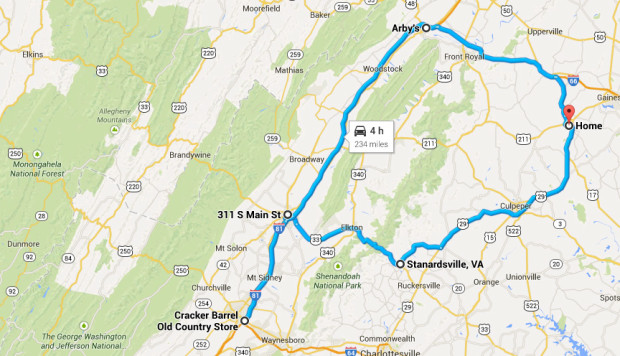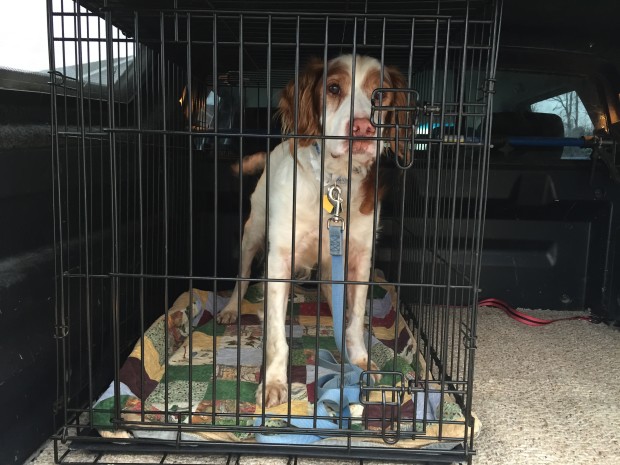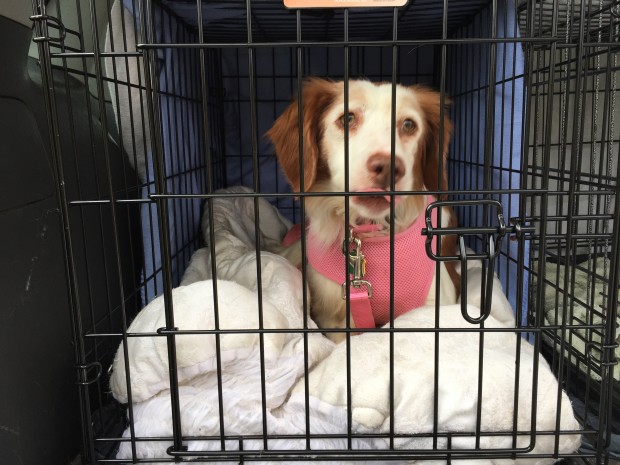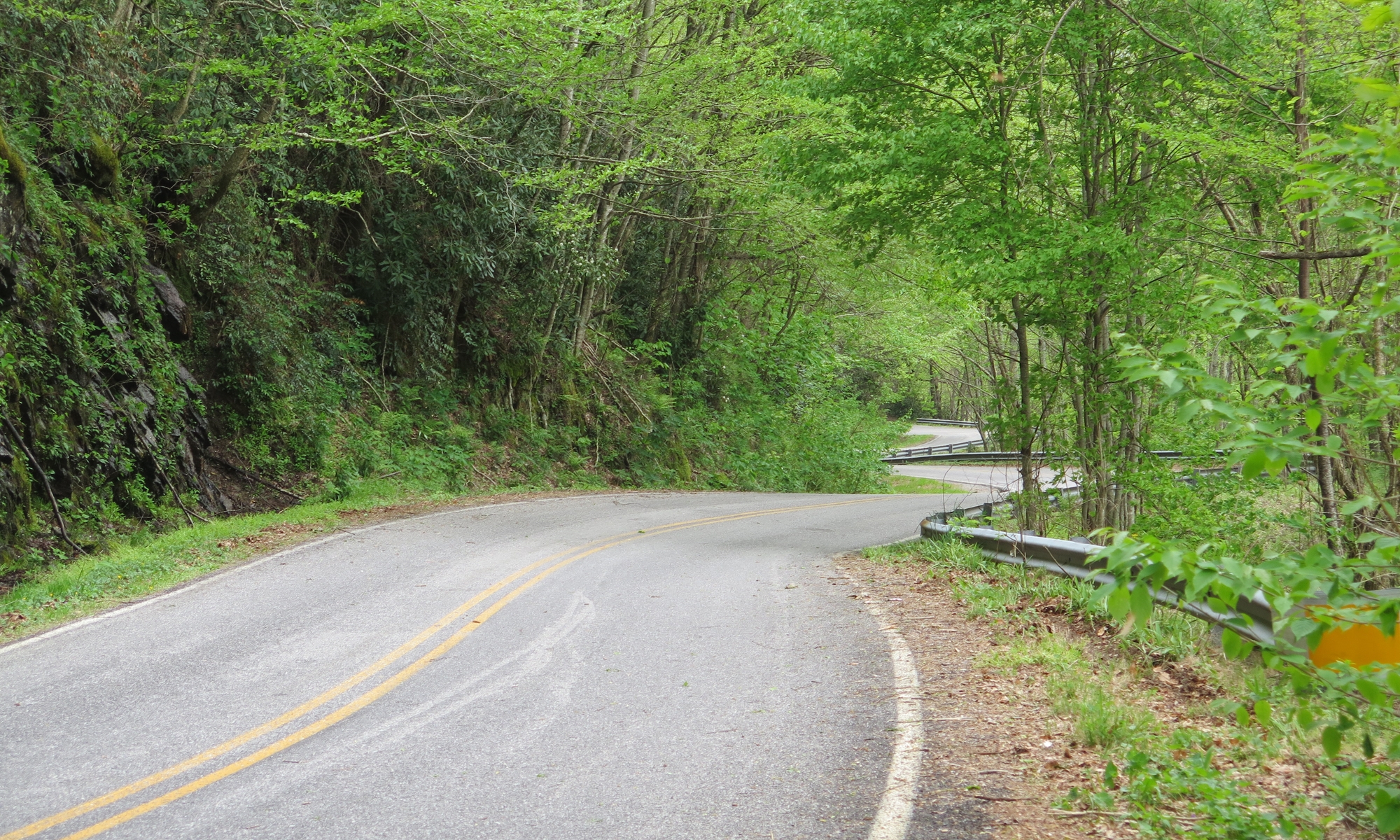I helped out on another doggie transport yesterday. I’ve mentioned transports here before. I even described a “transport” as a time when a dog rescue group needs to get a dog or dogs from point A to point B, usually over a long distance. Along the way, folks volunteer to drive 50- to 100-mile segments. It’s like a big doggie relay.
But that makes it sound so simple. There’s a TON of work, coordination, and cooperation that goes into pulling off these “relays,” and yesterday I was thinking a big shout-out is due to the folks who make this happen consistently.
Dog rescue is interesting. Cat rescue is similar, I’m sure. Sometimes, people wonder why it seems like one has to jump through so many hoops to rescue an animal in need. Those people, who have likely never been involved with a volunteer rescue group, fail to realize the level of effort, sometimes on a huge scale and involving many volunteers, that goes into rescuing an animal in need.
First, there’s the surrender/rescue. A volunteer has to accept the animal being rescued from an owner surrendering the animal. Or a volunteer has to pull an animal from a shelter, usually at the drop of a hat, because euthanasia is imminent.
Then that animal goes to a foster home. Ideally, the foster will be close to where surrender/rescue occurred. Sometimes, if there are no local foster homes with openings, the dog has to be transported over a long distance. On occasion, there are no available foster homes, and the animal has to be placed in a boarding facility, at great cost to the rescue group.
Remember, people volunteer to foster animals. That typically means one agrees to safely house, nurture, and feed the animal at their own expense. Fosters are also responsible for arranging for veterinary care. That can sometimes mean paying the vet bills then submitting receipts for reimbursement. Some rescues and vets will handle expenses among themselves, so the foster doesn’t have to pay.
When there are medical issues, and there usually are at least minor issues, the foster may have to medicate the animal, take it back and forth to the vet many times, nurse it back to health, etc.
Whether healthy or sickly, an animal usually spends at least a couple of weeks with a foster for evaluation. It’s a foster’s job to get to know the animal’s like and dislikes, personality, etc. For dogs, that means determining whether or not it is friendly to people, food-aggressive, has separation anxiety, likes cats or likes to kill cats, walks well on a leash, is content behind a four-foot fence, requires a six-foot fence, or is determined to escape from within any height or type of enclosure.
During this time, fosters can become attached to the animal. Which is why they care and want to make absolutely sure they end up in a good, safe place, with people who will care about them, treat them well, see to their medical needs, etc.
Sorry, that explanation got a bit longer than I’d expected, but it’s important.
As for getting a dog, or a cat, from point A to point B, it is the Transport Coordinator’s job to coordinate those efforts. Once they are notified that there’s an animal to be transported — they’re usually told the start and end points — they spring into action to map out a route. Things are never as easy as they sound, trust me. That mapping doesn’t just mean planning the route, but also breaking it up into segments, known as “legs,” manageable enough for volunteers along the way.
Then, they send out a transport request, typically by e-mail, but they also use other methods like Facebook posting, Internet forums/bulletin boards, perhaps a blog, etc. When I get these requests, I review each one to see whether or not there’s a NEEDED leg I can fill.
Here’s a map of my route yesterday.


New England Brittany Rescue (NEBR) and National Brittany Rescue and Adoption Network (NBRAN) share a Rock-star coordinator. Her name is Nancy Walker. Like many of us volunteers, she helps other rescues, too. (Other Brittany rescue groups, include American Brittany Rescue (ABR) and Brittany Rescue in Texas (BRIT), to name a few.)
Nancy will probably read this and accuse me of exaggerating about her contribution. But I’m not.
Nancy did call me. But only because she felt bad that I goofed and didn’t mention that she transports dogs for NBRAN and NEBR.
Sorry, NEBR, that was my fault entirely. I completely missed this in Nancy’s e-mail signature, “Brittany Transport Team – National Brittany Rescue (NBRAN)/New England Brittany Rescue (NEBR)”
Essentially, getting dogs where they need to be is a joint effort between groups, which just means an even bigger network of volunteers is involved.
Nancy also serves on the NBRAN Board. AND, in addition to Transport Coordinator, which is a full-time job in and of itself, she’s also the State Coordinator for at least four states. Being a State Coordinator for just one state is a big job. Describing what that entails will require a separate post.
I thought sharing the text from the request for the transport I was involved in on Saturday would help you appreciate the amount of work each transport involves. Do take a look at that run sheet, okay? A document like that is required for every transport. Each one.
Oh, and I just learned from The Rock Star herself earlier today that there’s a boatload of official government paperwork required for many of the transports, too. I had no idea there were specific laws, quarantine rules, and licensing requirements in some states. Some states even require foster homes to be licensed. Jeez. I’m sure there are reasons, but it just adds a whole ‘nother level of complexity to this already mammoth task.
On Saturday, Nancy the Rock Star was responsible for six transports. And sometimes, as with my transport, multiple animals are involved.
Nancy has to update each run sheet as legs are filled. Adding info such as driver names, contact information, vehicle descriptions, designated meeting place, etc. She publishes a final sheet before the transport starts. And then, while each transport is underway, it is Nancy who monitors the progress, fielding phone calls after each hand-off and sending e-mail updates to all drivers involved.
There were at least 23 drivers involved in just my transport alone yesterday. Think of all the e-mails and phone calls associated with just that one transport.
Wanna see yesterday’s passengers?


If you were wondering why Cracker Barrel at Exit 222 off I-81 was noted on the map, it was the meeting spot in Staunton. It’s convenient to the interstate, has a potty, which folks like me appreciate, and a big parking lot with a secluded grassy area that’s perfect for doggie potty stops, too. I’ve been there on at least two occasions when other rescue groups were also doing hand-offs. Arby’s was the meeting spot in Staunton. During my last stop there, at least one other group was handing off.
Diana, the lady I handed Cyrus and Princess off to in Strasburg, drove the two dogs north to Hagerstown, Maryland, another transport hot-spot, since it’s near the intersection of I-81 and I-70. A second transport was also heading south, so Diana brought another dog back to the Strasburg area. Diana also brought a borrowed crate (long story) back from Hagerstown with her, which I picked up from her in a nearby town this morning.
At least one other Brittany transport was going through Hagerstown yesterday, too, carrying a puppy from Michigan to Culpeper, Virginia.
Transports are a huge, HUGE part of the rescue process. I’m hopeful this post will inspire others to volunteer. It was a half-day road trip for me, which I thoroughly enjoyed. If you don’t have that much time, or don’t like to drive far, you could just volunteer for transports that pass a bit closer to your house. If you live near a major interstate, chances are very good that rescue transports are passing nearby all the time.
Just think about it, okay? It takes a lot more effort to rescue these animals than you might imagine. Every single volunteer and every donation, small or large, counts.
Before I sign off, I have to report that there was a bit of a hitch in yesterday’s transport plan. The dogs are all safe, but the transport got a bit stalled due to, get this, the volcano in Costa Rica!
Here’s some of the text from Nancy’s e-mail late last night.
Christine was supposed to pick up Dash and Cyrus tomorrow and take them home to Maine. She was vacationing in Costa Rica and has gotten stuck there due to the volcano erupting. The planes are not taking off due to the ash. She will probably get on a fight out of the tomorrow morning, but we are not sure, so Dash and Cyrus need to stay with LeeAnn instead of leaving in the morning.Princess will continue on as planned.
Nancy had to scramble into action again, to secure a place for Cyrus and Dash to rest their heads until Christine is available. Never a dull moment.
So, the next time you see a transport request, think about pitching in. Volunteering for a leg or two doesn’t require much effort, but it could be THE link in a chain that means life or death for an animal or animals.
Also, if you know Nancy, make sure you let her know how much you appreciate the fabulous job she’s doing. She’s a Rock Star, I tell you. NBRAN is very lucky to have her on their team.

What an amazing thing to do! It takes special people to do this & make sure the animals are well cared for.
Cyrus is a cutie! When Amy and I did the 800 mile transport to St. Louis a few years ago, I don’t think it occurred to me how many trips we were saving people! Glad we were able to help. 🙂
Shan, that was a HUGE help. That’s why I was so excited when it came up. The free overnight for you girls was a bonus.
Wow, so much work involved. Kudos to you and all the volunteers for doing these transports.
Not much work for me, I just had to drive. The amount of coordination required is what amazes me. Nancy said it really is like a full-time job.
Kathy, this is a wonderful volunteer effort you are a part of, and it sounds like you live right in the hotspot of travel too! Nancy IS a rock-star…as a recovering project manager, I can attest to the effort that must go into this level of coordination. 😉
Now all you need is the side car rig so you can do transports in nice weather on the bike. 😀